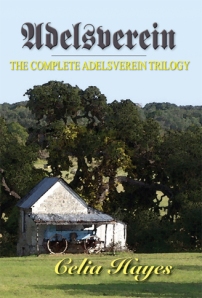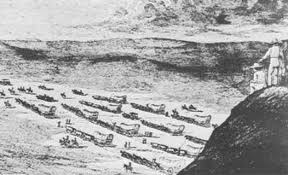At the start of the summer movie season in 2005, I was lamenting on my then-blog about the depths of my decided uninterest in anything premiering over the following months. I used to love going to movies, had subscriptions to Premiere, and to Entertainment Weekly . . . and then, somehow I just lost interest. The blog-lament turned into an essay about a dream movie epic – a frontier adventure that I would love to see made. The essay eventually became an epic itself, and a reader of the blog suggested that I work it into a movie treatment, as she had friends in “the business.” Nothing ever came of the movie treatment, until about a year later, when she showed it to a writer friend, who thought it was fantastic, but I would have better luck doing it as a novel first . . . and so did it become, within a very short time, with their encouragement. Now, as I am preparing a second edition of To Truckee’s Trail, through Watercress Press, I dug up the original series from the archives.
Hardly anyone has ever heard of this particular party of men, women and children. They blazed a trail in the wilderness, walked nearly three thousand miles, across plain and desert, and finally hauled wagons up a sheer mountain cliff. They set out into country unknown to most, and very possibly all, all for a gamble that life at the other end of the trail would be better. They are a footnote in the history books, going under several different names. They seemed to have functioned as a kind of self-organizing committee, although they had formally elected a leader, as was the custom of the trail. They had no diarist, no tireless letter-writer or professional memoirist among them, no extensive first-hand contemporary accounts; they were ordinary people … but on an epic journey.
In the year 1844, these United States, for all intents and purposes, extended from the Atlantic seaboard to the Mississippi/Missouri River. And west of the rivers, two-thirds of the continental territories theoretically American were an unknown quantity. Desert, high plains, mountains, rivers – only a bare handful of explorers, missionaries and fur trappers had ever seen for sure what lay beyond the jumping-off point at Council Bluffs, Independence, St. Joseph. There was a slender and perilous established overland trail to Santa Fe, and beyond that to the thinly-populated enclave of Spanish and then Mexican territories inCalifornia. That trail wound through the scrub and deserts of the Southwest, traveled mostly by professional traders and merchants, heavily armed and escorting great lumbering Conestoga wagons packed with profitable trade goods: fabrics and glass, gunpowder and tools, for the markets in Santa Fe, and the outlaying pueblos. They were businessmen, with little interest in lingering, since most of the route lay though desert.
There was another trail, also — a northern track which followed along the PlatteRiver, through deserts and mountains, and eventually terminated in Oregon. Lewis and Clarke, the fur-trapping brigades – all had gone in that general direction, by boat, on horseback and on foot. And by the 1840s, hearing of the rich lands in the Pacific Northwest, farmers and small tradesmen had begun to follow the siren call also. An agricultural depression, epidemics of malaria and yellow-fever, a bit of manifest destiny, ambition and just plain restlessness no doubt played a part.
Families across what is now the middle-west sold off land and assets; this was not a journey for the impoverished, or the reckless. Aside from a wagon, and stock to pull it, these adventurers would have to bring along supplies for six months, tools, clothes, bedding and cooking gear, spare parts for the wagon, perhaps seeds and roots to plant a new garden in the Willamette Valley, or by Sutter’s Fort in far California. There might be some little space in the wagon for some books, and china and other small treasures, for the wagons were small, and food took up most of the space. The larger wagons, purpose-built for the trail were about four feet wide, ten to twelve feet long, covered with waterproofed canvas, spread over four or five arched hickory bows, although many families made do with ordinary farm wagons, fitted out with a cover. The draft animal of choice was not the horse, as many would think. Horses were expensive, and the road was rough, too rough in the early days for even the toughest horse in dray harness. Mules made a good showing on the southern trail, but they were expensive. Most emigrants could better afford ox teams; four to six pair to a wagon, patient and plodding, guided by a driver who walked by the lead team and shouted verbal commands.
The wagons rolled on metal-tired wheels; there was no suspension system, no springs. Most emigrants walked by choice, rather than endure jolting along in a wagon. It would take six months, easily – and in the early days there was no known road, and only two or three outposts all along that way to buy additional supplies, or to mail a letter. The pioneers looked out from the noisy clamor of St. Joseph, and Independence, and Council Bluffs at last years’ tracks and ruts, overgrown with the new grass that would feed their ox teams on the first part of the journey, as soon as it was grown tall enough. They looked at two thousand miles of wilderness. They would step off the safe perch, on the riverbank at the edge of civilization, and swing out like a trapeze artist across the vast, emptiness, guided by their own good sense, and hard work, faith and hope and no little amount of luck – but they would not go alone.
Late in of May, 1844 such a party of emigrants stepped off from Council Bluffs, in company with a larger party bound for Oregon. Ten families, with as many (or a few more) wagons, with all their stock and worldly goods had elected an ex-trapper and blacksmith named Elisha Stephens as their own leader, and intended to strike off the established trail at Fort Hall, and head for California.
All the other archetypal western stories are almost exclusively male domains. The writer of a romantic yard about cowboys and the open range, the Gold Rush, the mountain men, or the fighting cavalry, must go to great length to import an adventurous school-marm or a tart. But the emigrant wagon trains, the great Mormon migration, and the post-Civil War homesteaders, they were all family matters. Stephen’s party of fifty souls included eight women and fifteen children. A little under half of them were an extended clan: Martin Murphy, and his three adult sons, with their wives and children. Martin Murphy himself had emigrated from Ireland, to Canada, and then to Missouri. His wife and a grandchild had died in a malaria epidemic; the clan sought a healthier climate, and Martin Murphy thought all the better of California— still held byMexico — for being nominally a Catholic country. Dr. John Townsend, very possibly the most educated person in the party, also looked to a healthier climate; his wife, Elizabeth, was supposed to be in frail health. Elizabeth Townsend’s orphaned younger brother, Moses Schallenberger, counted as a man for this journey, at the age of 17. The teenaged half-Indian sons of Caleb Greenwood probably also counted as men. Caleb Greenwood had roamed all over the Rockies and the Great Baisin as a fur-trapper, twenty years before. Greenwood was thought to be in his eighties, but still hale and vigorous. Another old mountain-man, Isaac Hitchcock also felt the lure of the west, traveling with his oldest daughter and her children.
None of these men; Stephens, Greenwood, or Hitchcock had been all the way along the trail they proposed to follow to California. It is thought that Stephens may have worked as a teamster or wagon-master on the Santa Fe Trail, and a descendent of Isaac Hitchcock found evidence in archives that Old Man Hitchcock had been in California briefly in the 1820s. Stephens seems also to have been enormously respected by the other men; there were none of the bitter divisions that fractured other parties, under the stress of moving the heavy-laden wagons an inexorable fifteen miles a day, and chivvying the stock herd, finding water and safe pasturage, of being dusty and exhausted and hungry, day after grinding day, and knowing that the hardest part of the journey was at the end of it.
(To be continued)






Recent Comments